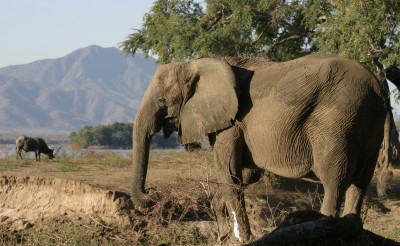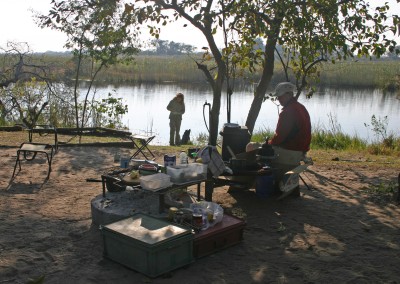Mana Pools National park abounds with wildlife. After our first full day in the park we have already seen kudu, impala, baboons, vervet monkeys, waterbuck, warthog, zebra, crocodile, giant eagle owl, Meve’s starling, southern ground hornbill, barred owlet, red-billed firefinch, saddlebill stork, brown snake eagle, black-headed oriole and a tawny eagle with a monitor lizard in its mouth.
The charm of walking safaris is to be able to follow animal footprints, droppings and other clues. It is like a treasure hunt! One morning we walk straight up to a pride of lions with a fresh kudu kill. There are four adult female lions, a few teenagers and about six cubs sampling the bloody goods. The lions make eye contact with us and start flicking their tails angrily. I know from my domestic cat at home that a flicking tail means angry. We keep our distance and huddle behind a large fallen branch. A buffalo approaches the lion pride from the other side and stresses the lions even more, so we quietly move off and let them eat their breakfast in peace.
Another morning we find ourselves face to face with a grumpy elephant. We have just climbed out of the car, ready to go for a walk, when we spot the young male and he spots us. He is very close. He interrupts his breakfast of tree branches to start waving his trunk all over the place, trying to catch and identify our smell. Then the waving turns to an aggressive show of trunk, trumpeting and ear-flapping and he mock charges us. My heart beats like there is no tomorrow.
We scurry behind a termite mound while our brave guides Mike and Bernard act as decoys. They clap their hands to try and scare the elephant away. Meanwhile, another elephant comes running to see what all the fuss is about and perhaps to offer reinforcement. He is just a young whippersnapper. The first elephant is more confused by than appreciative of this sudden intrusion by the youthful elephant, which gives us a chance to back off and disappear in another direction.
I can get tetchy, too. Ever since we entered Mana Pools I have been inadvertently feeding the wildlife. Tsetse flies. They home in on my apparently delectable body and feed on it, sucking blood like horribly hungry mini-vampires. These little devils are the bane of Mana Pool life. The bite hurts but the worst part is the itch, which lasts for days. It is as though the itch extends to deep down into the muscle (well, fat, in my case) and cannot be satisfied by any amount of scratching. They are terrible little beasties that make me testy and tetchy, itchy and scratchy.





















































